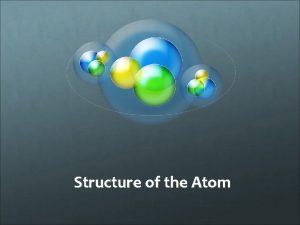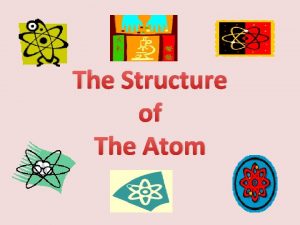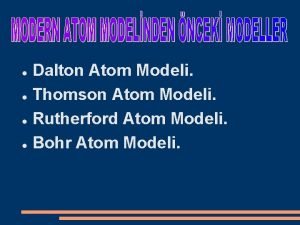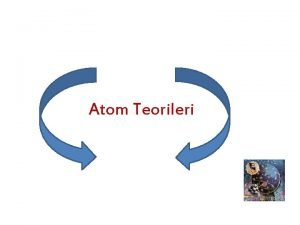Structure of the Atom The Atom Today Atom













- Slides: 13

Structure of the Atom

The Atom Today Atom: the smallest particle of an element that retains the properties of that element All matter is made up of atoms Atoms are made up of subatomic particles

The Nucleus • Tiny region at the centre of the atom • Most hydrogen atoms: contain one proton • All other atoms: contain both protons and neutrons • Number of protons determines charge of the nucleus and the identity of an atom

The Electron Energy Shell Electron energy shell • Region that electrons occupy accounts for over 99. 99% of an atom’s volume • Electrons occupy specific regions (energy levels) that surround the nucleus • Electrons are like a spread-out cloud of negative charge that exists in the whole region at once

Electric Charge • Comes in two types: positive and negative • Protons: positive charge (1+ each) • Electrons: negative charge (1– each) • Neutrons: no charge • Positive charge of protons in the nucleus attractions electrons • Overall charge of an atom: uncharged/neutral (equal numbers of protons and electrons)

Nuclear Force (Strong Force) • Acts within nucleus to hold protons and neutrons together • Very strong across very short distances • Strong enough to counteract the repulsion between protons, keeping nucleus from flying apart

The Atom Summary Symbol Electric Charge Relative Mass proton p+ 1+ 1836 nucleus neutron n 0 0 1837 nucleus electron e– Name 1– 1 Location in the Atom surrounding the nucleus

The Atom Summary Symbol Electric Charge Relative Mass proton p+ 1+ 1 nucleus neutron n 0 0 1 nucleus electron e– 0 surrounding the nucleus Name 1– Location in the Atom

Subatomic Particles The atom is made up of smaller particles called subatomic particles Some subatomic particles are made up of even smaller particles

Quarks are elementary particles (cannot be split apart into smaller particles) Six different “flavours” based on properties such as mass and charge: up, down, strange, charm, top, and bottom

Quarks Protons and neutrons are composite particles (made up of quarks) Also contain elementary particles called gluons, which act as a glue that binds quarks together Experience the nuclear force (strong force), which is also involved in binding quarks together

Leptons Electrons are elementary particles called leptons Come in six “flavours”: electron, muon, tau, electron neutrino, muon neutrino, and tau neutrino Do not experience the nuclear force (strong force)

Table 2. 4: Characteristics of Leptons Lepton electron muon Description • The electron is the lepton found in atoms. • Compared to the electron, muon and tau particles have the same charge (1–) but a much greater mass. tau electron neutrinos muon neutrinos tau neutrinos • Neutrinos are very difficult to detect. They have no charge and are nearly massless. • Trillions of them pass through our bodies each second. • Neutrinos are produced by high-energy processes such as nuclear reactions in the Sun.

























